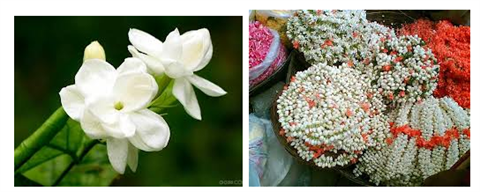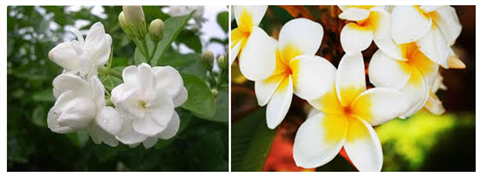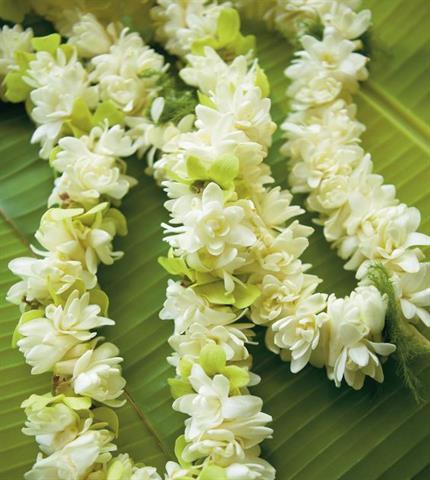JASMINE
Contents
- Introduction
- Description of the plant
- Puranic Reference
- Ayurvedic uses
- Significance
Introduction
Jasmine flower known as Mallika in Sanskrit is popular for its sweet fragrance. The taxonomic name is Jasminum. The scientific name of Jasmine is Jasminum Officinate. It belongs to the family of Oleceae. The English Synonyms are True Jasmine, Star Jasmine, Night Blooming Jasmine and Jessamine. The other names of Jasmine are Mogra, Chameli, Johi, Jati, Kundumalligai, “queen of flowers” and Arabian Jasmine. It is also popularly known as the “Moonshine in the garden”. The name Jasmine is derived from the Persian “Yasameen” (gift from the god).

Description of the plant
Mallika is a climbing vine which grows up to 10-15 ft in height. Jasmine is either deciduous (the leaves fall in autumn) or are evergreen throughout the year. There are than 200 species of Jasmine grown in Eurasia, Australasia and Oceania. Some of the species of the plant are shrubs or erect or spreading. Jasmine is a plant indigenous to India, Southeast Asia, Africa, and Australia. It is found extensively in South India.
The pin wheeled shaped flowers either bloom in clusters or can be a single flower on the ends of the brachlets. The tubular and star shaped, waxy textured flowers are milky white or yellow colour. The flowers are plucked in the evening as their fragrance is strong during late evenings. Each flower consists of 4-9 petals depending upon the variety of the flower. The blooming season of the flowers varies on the type of the flower. While some varieties of Jasmine bloom throughout the year, some varieties bloom during June to October, or during March to May.
Leaves are simple, trifoliate or pinnate. The leaves are shiny, alternate and oval shaped.
The fruits of Jasmine are berries which turn black when ripe. Jasmine plants are found all over India, though extensively in South India. It is propagated through cuttings and sown in soil 6 inches deep. The plant requires moist soil for good growth. Younger plants should be tied to a stem for support. It is cultivated in Algeria, Morocco, France, China and Egypt. Another variety of Jasmine known as False Jasmine or yellow jasmine, Gelsemium Sempervirens has a similar fragrance. They contain toxic alkaloids which are poisonous and are fatal.
Some of the following plants have similar name and fragrance but are not related to Jasmine.
- American Jasmine ((Quamoclit coccinea).
- The Red Jasmine (Plumiera rubra), native to Central America.
- The Cape Jasmine (Gardenia Florida)
- The Ground Jasmine (Passerina Stelleri), native of the Cape.


Puranic Reference
Kamadeva, the Lord of love has jasmine as one of the five flowers in his arrow. There is a mention of Jasmine flower in Rudra Samhita, Section -5, Yuddha Kanda, Ch 26 where the flower is said to be born of goddess Lakshmi.
Ayurvedic uses
Jasmine is known as Nava-Mallika, Shita-bhiru, Madyantikaa, Vaarshiki and Madayanti in Ayurveda. Flowers, leaves, roots and jasmine oil are used for medicinal purposes since ancient times.
Flowers
Jasmine contains several compounds such as salicylic acid, linalool, and other alkaloids. These give its bitter, cooling, and astringent properties. Jasmine flowers act as Anthelmintic (drugs used to expel intestinal worms), deobstruent, diuretic, Emmenagogue, (stimulate blood flow in the pelvic area and uterus) Astringent, Antidepressants, Aphrodisiac, Aromatic, Neurasthenia (a psychological disorder marked by easy fatigability, feelings of inadequacy and lack of motivation) and Stimulant agents. In Ayurveda, jasmine oil and flowers are used to treat ailments caused by Pitta and Kapha doshas. Excess use of jasmine oil/flowers is said to cause high vata and severe chills.
For medicinal purposes, the flowers are either ground to a fine paste or dried and powdered. The flower buds having anti ulcerative properties are effective in treating peptic ulcers and gastric ulcers. It is also effective in treating jaundice, vesicles, boils, hiccoughs, bee stings, fever, swollen eyes, vomiting and to arrest the secretion of breast milk.
Jasmine Oils: Jasmine oils are extracted from the flowering buds by solvent extraction method. To extract 1 ml of jasmine oil, nearly 8000 flowers are processed which makes, Jasmine oil one of the most expensive oils in the world.
Jasmine oils have a bitter sweetish taste, and strong aroma. Jasmine oil contains benzyl acetate, terpinol, jasmone, benzyl benzoate, linalool, several alcohols, and other compounds. Jasminum grandiflorum and Jasminum officinale are the two types of jasmine plants which are widely used for oil production. Jasmine oil acts as Analgesic (mild), antidepressant, anti-inflammatory, antiseptic, antispasmodic, aphrodisiac, carminative, cicatrisant, expectorant, galactagogue, parturient, sedative and a tonic for the uterus. Jasmine oil is extensively used in aromatherapy. The attar or perfumes made of Jasmine are popular all over the world.
Uses of Jasmine oil: Jasmine oil has a cooling and soothing effect. Thus it is highly effective in treating headaches and sunstrokes. Jasmine oil is used to treat burning urethra, diabetes mellitus and Hodkin’s disease.
Jasmine flower/oil is used to treat the following ailments:
-
Anxiety and stress: Jasmine is a sattvic flower highly beneficial in treating pitta or kapha types of depression, anxiety and stress. One gram of jasmine oil should be
mixed with any base oil and massaged on the skull. After 10-15 minutes, taking a shower or bath helps to reduce anxiety and other stress related issues. Alternately few drops of Jasmine oil used in the bath water will have a calm and soothing effect on the mind. It removes body ache too. - Respiratory ailments: The antiviral and expectorant properties of jasmine oil help in treating respiratory disorders. A concoction of the flowers mixed with honey is beneficial in treating coughs and hoarseness. Alternately, adding 2 drops of jasmine oil to water and inhaling the steam annihilates cold, cough, bronchitis sinusitis and nasal congestion.
- Emotional imbalance and depression: Jasmine flowers and oil act as antidepressants, thus highly beneficial in treating depression, agitation, emotional imbalance and headache due to stress. Jasmine oil is a natural remedy for treating depression. Inhaling few drops of jasmine oil controls negative thoughts and reinforces positive emotions, strengthens the mind and improves self confidence. Jasmine flowers are used to treat the heart chakra, the seat of emotions. Inhaling the fragrance of jasmine oil/flowers increases emotions such as love and compassion. It is effective in treating loss of memory, irritation and other mental disturbances. Jasmine flowers are highly beneficial in treating mood swings during menopause. Jasmine oil is used in treating post natal depression too.
- Intestinal Worms: A concoction of jasmine flowers is an antidote for intestinal worms.
- Skin ailments: Jasmine flowers and oil are a natural remedy for a host of skin related disorders or allergies. Two drops of jasmine oil added to creams or lotions and applied on the face improves the skin texture, makes the skin radiant, moistens the skin and removes any blemishes or rashes. The cicatrisant and collagen enhancing properties of Jasmine essential oil is an antidote for treating stretch marks and scars. The fresh juice of the ground flowers is effective in treating itching, sores and wounds on the skin.
- Anti Cancerous: The flowers and leaves have anti cancer properties which makes it a natural remedy for treating different types of cancers. A paste of the flowers or oil strengthen the lymphatic system and is helpful in treating various types of cancer like bone cancer, breast cancer, lymph node cancer etc. The synthetic compound extract from Jasmine is useful in treating cancerous tumours.
- Excessive bleeding: Jasmine flowers having antibacterial and antiviral properties are best used to treat impending cramps and reduce clots during menstruation. The bitterness and astringent properties of the flower are used in treating excessive menstrual bleeding.
- Eye infections: Washing eyes with a cold concoction of jasmine flowers alleviates burning and irritation in the eyes. It is also used to treat conjunctivitis. A concoction of the leaves of a variety known as Eastern Jasmine is applied on the skull to treat ailments associated with the eyes.
- Headache: Application of Jasmine oil on the forehead or inhaling the aroma of a few drops of jasmine oil is useful in treating headache caused due to pitta. Jasmine oil should be mixed with other heating oils while applying on the body. During winter season, application of jasmine oil should be avoided.
- Strengthens liver: Jasmine is effective in strengthening the liver, hence used to treat cirrhosis and hepatitis.
- Poisonous stings: Application of the extract of the flowers or oil on the affected area gives relief from poisonous stings.
- Aphrodisiac: Jasmine oil stimulates the male and female reproduction system, thus useful in treating aphrodisiac and other sexual disorders.
- Inflammation: The anti inflammatory properties of Jasmine are highly beneficial in treating inflammation. For relief from pain or any inflammation, two drops of jasmine oil mixed with 1 ml of olive oil and applied gently on the painful area acts as a natural remedy.
- Increase the immunity of the body: The antibacterial properties of the oil help in fighting against bacterial infections in the body. Thus it helps in strengthening the immunity levels in the body.
- Hearing: Jasmine oil is used to treat ear infections.

Uses of leaves: The leaves of Indian Night Jasmine (Nyctanthes arbortristis - N.O. Jasminaceae) are used to make a tincture for rheumatism, sciatica and bilious fevers in Homeopathy. A concoction of the young leaves is effective in treating gallstones. An extract of the juice of the leaves is used in treating corns.
Uses of Jasmine root: Jasmine root oil is used to arrest the secretion of milk. A mixture of the root extract is used to treat diabetes. A paste of the roots is used to treat labour pain. Roots are also used to treat pain and inflammation due to broken bones and dislocated joints.
Jasmine Tea: In China, the extract of the flowers or dried flowers is used as herbal tea to treat fever, urinary inflammation, anxiety, stress, heat stroke, and as tincture to treat wounds.
Other Uses: Incense, oil, perfumed shampoos and soaps are made of Jasmine. Jasmine is used in culinary purposes in making candies, puddings, desserts, and dairy products. A variety of Jasmine known as Chameli is used for making perfumed hair oils. Jasmine oil is used in vaporizers, burners and aroma lamps.
Significance
Mallika is used in the worship of gods and goddesses. The flowers are sacred to Lord Vishnu and Siva. Jasmine flowers are stringed together to make garlands. In Mathura Museum, there is a terracotta image of Kamadeva with his arrow which has Jasmine among the five flowers.
The flowers are worn by women in their hair in Southern and Southeast Asia. Jasmine is the national flower of Pakistan, Philippines and one among the three national flowers of Indonesia. In Phillippines, it is known as Sampaguita meaning “I promise You” and is a pledge of mutual love. Jasmine represents strength, simplicity, sacredness, humbleness and purity. During Buddha’s time, Jasmine oil was used to anoint kings and wealthy people.
http://en.wikipedia.org/wiki/Jasmine
http://www.ecoindia.com/flora/flowers/jasmine-plant.html
http://www.home-remedies-for-you.com/herbs/jasmine.html
http://www.anniesremedy.com/herb_detail29.php#
http://www.agriculturalproductsindia.com/flowers/flowers-jasmine.html
http://ayurvedicoils.com/tag/ayurvedic-health-benefits-of-jasmine-oil
http://www.kamleshayurveda.com/top/jasmine.htm
http://www.botanical.com/botanical/mgmh/j/jasmin06.html. http://www.selfgrowth.com/articles/Jasmine_Herbal_Remedy_Uses_And_Properties.html (read the link)http://www.vaikhari.org/flowers.html
http://en.wikipedia.org/wiki/Kamadeva
http://userwebs.theriver.com/innerguide/sivaPurana/part06.html
http://ayurvedicoils.com/tag/jasmine-oil

